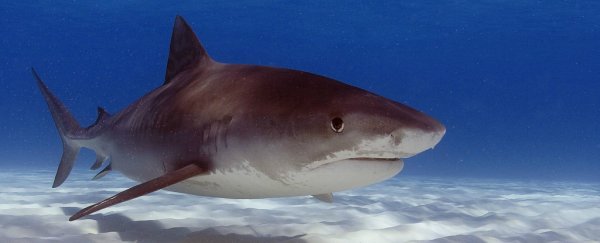Shark populations off the east coast of Australia have been declining over the past 55 years with little sign of recovery, according to research published in the journal Communications Biology.
Coastal shark numbers are continuing a 50-year decline, contradicting popular theories of exploding shark populations, according to an analysis of Queensland Shark Control Program data.
University of Queensland and Griffith University researchers analysed data from the program, which has used baited drumlines and nets since 1962 to and now covers 1,760 km of the Queensland coastline.
Chris Brown from Griffith's Australian Rivers Institute says the results show consistent and widespread declines of apex sharks — tiger white sharks and hammerheads — along Queensland's coastline.
"We were surprised at how rapid these declines were, especially in the early years of the shark control program. We had to use specialist statistical methods to properly estimate the declines, because they occurred so quickly," says Brown.
"We were also surprised to find the declines were so consistent across different regions."
Some species, such as hammerhead sharks, were recognised internationally as being at risk of extinction.
"Sharks are an important part of Australia's identity. They are also survivors that have been around for hundreds of millions of years, surviving through the extinction of dinosaurs," he says.
"It would be a great tragedy if we lost these species because of preventable human causes.
"Sharks play important roles in ecosystems as scavengers and predators, and they are indicators of healthy ecosystems. These declines are concerning because they suggest the health of coastal ecosystems is also declining."
George Roff, a UQ School of Biological Sciences researcher, says historical baselines of Queensland shark populations are largely unknown despite a long history of shark exploitation by recreational and commercial fisheries.
"Explorers in the 19th century once described Australian coastlines as being chock-full of sharks, yet we don't have a clear idea of how many sharks there used to be on Queensland beaches," he says.
"Shark populations around the world have declined substantially in recent decades, with many species being listed as vulnerable and endangered."
Researchers discuss their findings:
The research team reconstructed historical records of shark catches to explore changes in the number and sizes of sharks over the past half century.
"What we found is that large apex sharks such as hammerheads, tigers and white sharks, have declined by 74 to 92 per cent along Queensland's coast," Roff says.
"And the chance of zero catch – catching no sharks at any given beach per year – has increased by as much as seven-fold.
"The average size of sharks has also declined – tiger sharks and hammerhead sharks are getting smaller."
"We will never know the exact numbers of sharks in our oceans more than half a century ago, but the data points to radical changes in our coastal ecosystems since the 1960s.
"The data acts as a window into the past, revealing what was natural on our beaches, and provides important context for how we manage sharks.
"What may appear to be increases in shark numbers is in reality a fraction of past baselines, and the long-term trend shows ongoing declines.
"While often perceived as a danger to the public, sharks play important ecological roles in coastal ecosystems.
"Large apex sharks are able to prey on larger animals such as turtles, dolphins and dugongs, and their widespread movement patterns along the coastline connects coral reefs, seagrass beds and coastal ecosystems.
"Such losses of apex sharks is likely to have changed the structure of coastal food webs over the past half century."
The research is published in Communications Biology.
This article was originally published by Business Insider.
More from Business Insider:
